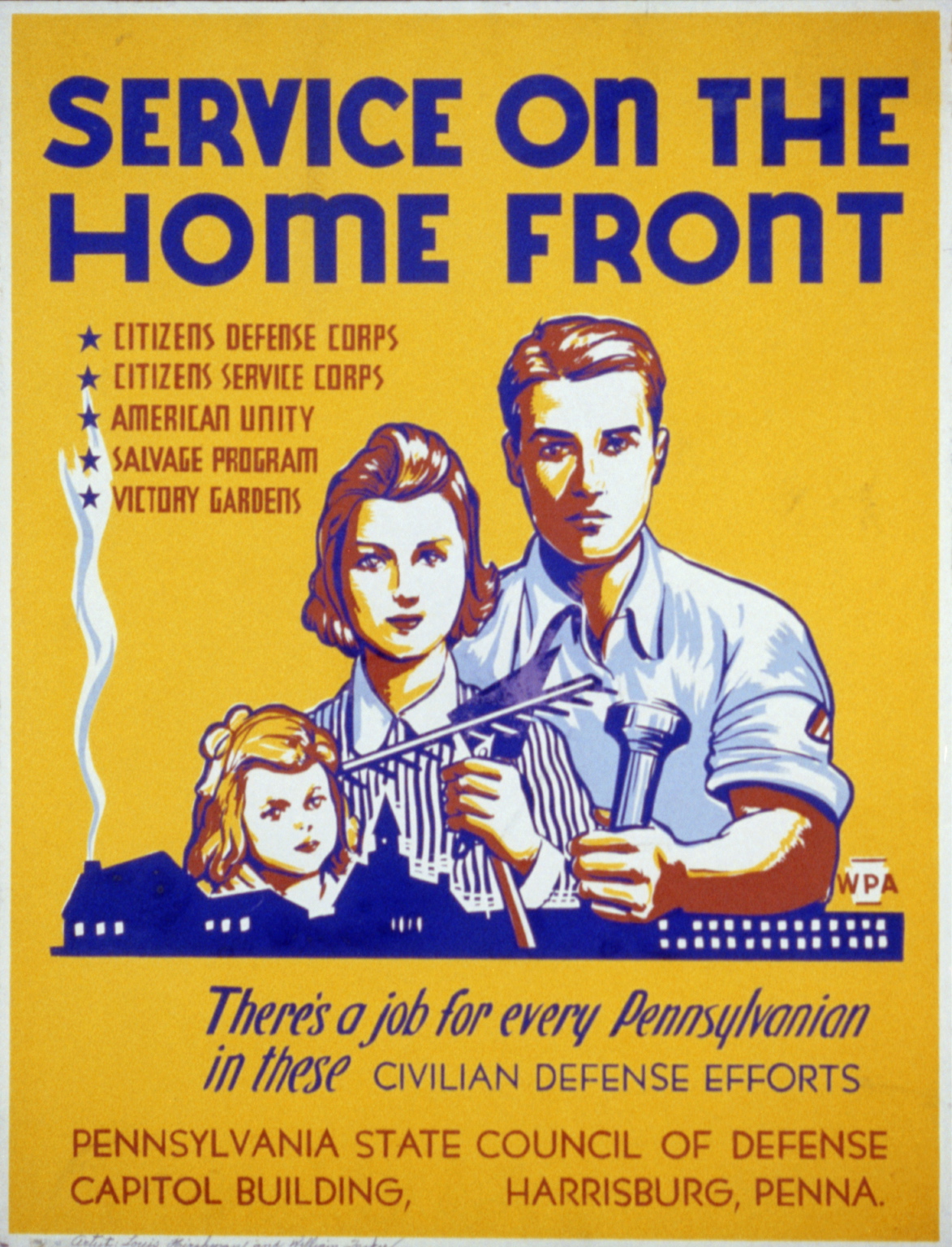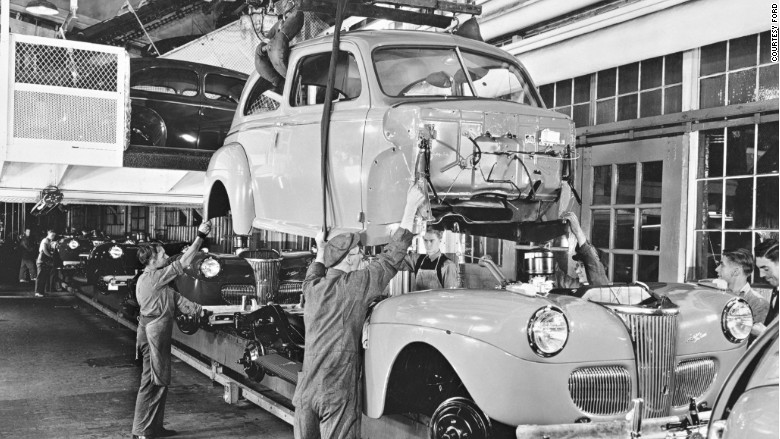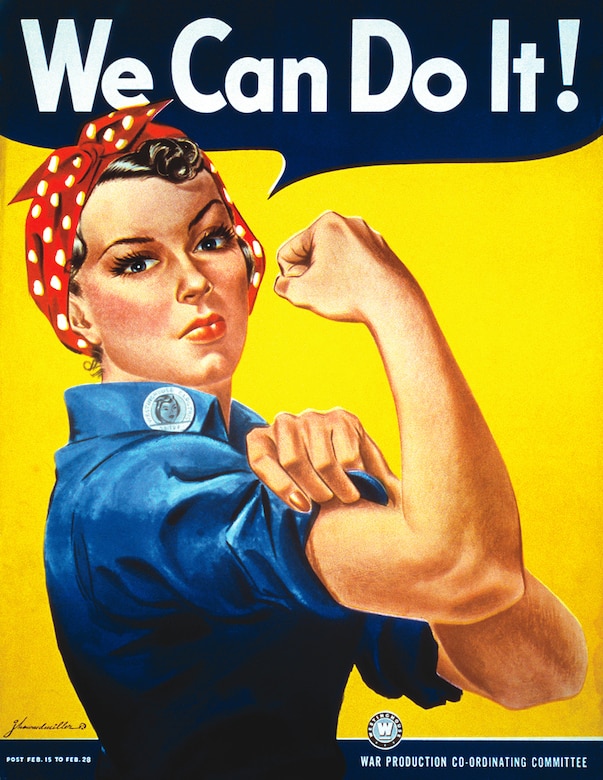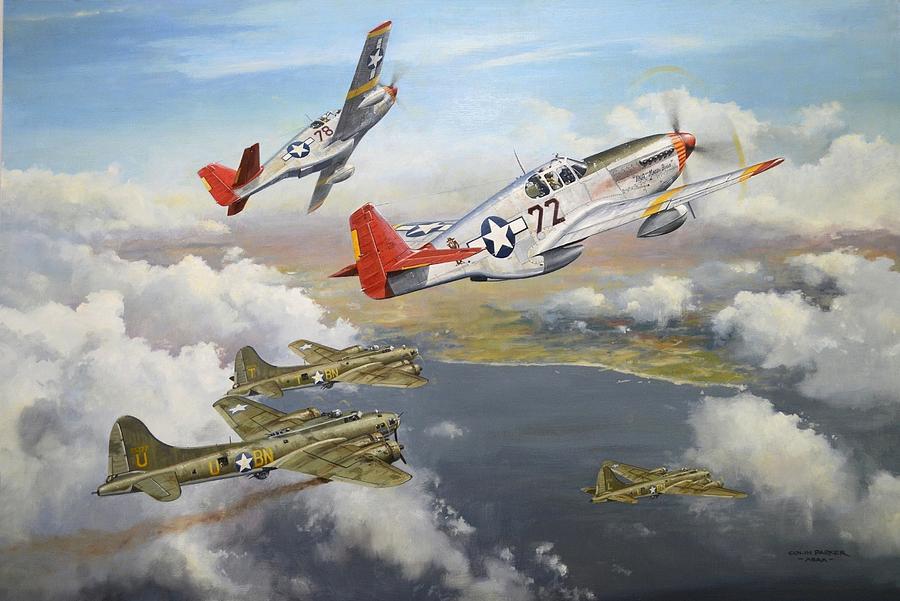U.S. Homefront - A/H
Listen to "WW II - Module 9 - U.S. Homefront" on Spreaker.
*********************************************************************

The Homefront describes all of the homes, businesses, government groups, newspapers, radio stations, and factories back in the United States. Since it was their sons, husbands, fathers, brothers who were fighting and dying, the people at home wanted to help support their efforts. It was also their daughters who had gone over to help the war effort by doing different things in different ways. People on the Home-front wanted to support their efforts.



A song from the time about saving the fat for explosives
Conserving Money – Buying War Bonds


He was my Dad.
Nisei:Internment Camps
The links below will help you with translating tools between English and Spanish.
1. Audio of a words in both English and Spanish. Will also translate phrases.
2. Google Search - Espana: The word can be typed in English, and the search finds results in Spanish, including images.
2. Google Search - Espana: The word can be typed in English, and the search finds results in Spanish, including images.
3. Google Arabic is available.
U.S. Homefront

Introduction
Factories Producing War Goods Bring End To Great Depression
How, you ask, did producing war goods end the Great Depression??? Quite simply it put people back to work. A LOT of people. Making all kinds of things.

You can see that the unemployment rate went from about 17% in 1939 when the war started, to almost 0% in 1944, which was 5 years into the war.
Products Made For War That Put People Back To Work
Bullets of many sizes, cannon shells of many sizes, guns, tanks, airplanes , jeeps, trucks, parachutes, navy ships, clothing, shoes, rubber for hoses, gasoline, coal, desks, chairs, books, paper, knives, candy, etc. The list could go on and on, but you get the idea.
Then there were all the people who now had jobs moving this stuff. Truck drivers, train workers, airplane pilots.
Then there were the 16,000,000 people who had jobs in the Army, Army-Air Corps, Navy, Marines, and Coast Guard using all of this stuff. THEY were getting paid to do a job. (When the war started we only had 1,686,000 in the army. Two years before that (1939) in had only been 374,000.).
Case Study (Ford and The B-24)
B-24 bombers being finished at the Ford factory at Willow Run, Michigan
See how it was similar to making cars???
See how it was similar to making cars???
A Case Study is when we look at one example to understand a big idea. The big idea we are learning here is just how did making goods for the war help end the Great Depression. The simple answer is that it gave people jobs. The example of the B-24, one of our heavy bombers used to defeat Germany and Japan, will help us see this main point.
Henry Ford  (you remember him), built an entire factory to make B-24 bombers by himself.
(you remember him), built an entire factory to make B-24 bombers by himself.
This is the factory at Willow Run Ford built to make B-24 bombers for the U.S. Army. Look at the runways in the back they used to fly the planes away so they could be used against the Germans and Japanese
Companies that used to be in competition now worked together to provide the weapons and equipment needed by our fighting men.
B-24 assembly line. This was like car assembly line. Only for planes that dropped LOTS of bombs. On the enemy.
It was designed by Consolidated Aircraft Company. It was then produced by Ford Motor Company, Douglas Aircraft, and North American Aviation. In all, 18,482 B-24s were built by September 1945 when the war was over.
How Did Making Products For The War Have An Effect On The Great Depression???
You MUST remember learning that one of the major problems of The Great Depression was unemployment. The war mostly solved that be creating demand for products. Factories needed employees to make the stuff.
Henry Ford’s B-24 plant helps us see that. When it opened in 1941, people thought the factory at Willow Run would employ A LOT of people because it was the largest indoor factory under one roof, IN THE WORLD . It was equal to the space of 61 NFL football fields. Early on, however, the plant was hurt by labor shortages (not enough people to work)
Women and African Americans Getting Work
This problem was solved by getting workers from the South, such as African Americans. Many Women were also hired, and houses were built for employees. Willow Run eventually employed over 42,000 people and by 1944, the plant was producing one plane every hour.
This same kind of thing was repeated all over the country in many different factories, making many different products.
For More Detail on wartime employment and the Homefront click on THIS link.
Protecting The Production
In California (on the Pacific Coast) there was some fear that the Japanese would be able to attack there. Many companies making war goods were located in California, one of them being the Lockheed Company that made aircraft. One of the VERY useful planes they made was called the P-38 Lightening
P-38 Lightening
In order to protect the factory making the planes they designed and made a very fancy way to camouflage (hide) it. This was done in case there was an attack it would not look like a factory, but like a regular neighborhood.
Here is the factory before they put on camouflage.
Here it is what the same area looks like afterwards.
Here is what it looks like underneath part of the camouflage.
Women Take Jobs In Defense Plants
A Defense Plant is a factory making products for the war effort. Up to this time most, but not all, workers in factories were men. Now many of the men were off in the Army, Navy, and Marines fighting the Axis Powers (Germany, Japan, and Italy).
Factories needed to find workers from some place, and women were a large and available source of workers.
They made Machine Gun Ammo.
They operated heavy tools to make pieces for BIG things like tanks.
They worked making ships for the Navy.
They worked on farms.
They worked putting the pieces of an airplane together.
This last example shows women using a machine called a riveting machines that used something like a staple to connect pieces of metal. In the last picture you saw the women using the riveting machines to make a B-17 Heavy Bomber.
Hear a bit of the story...
Hear a bit of the story...
Rosie The Riveter
Women working in factories putting the pieces of airplanes together with riveting machines gave rise to an image that came to stand for all women workers in factories during WW II. She was called “Rosie The Riveter.”
Another version of “Rosie” looks like this:
You can then hear a song from the time about Rosie The Riveter
Conserving and Rationing
What they mean and how they can support war effort
Conserving means to use things wisely and not waste them. In other words use as little of something as you can so that it will last longer.
Rationing means that you hold your use of something to a set limit. Often there is somebody telling you that you must do it. This usually is the government.
During WW II at home in the U.S. we needed to do both because so much of what we had was being used to fight the war. Making supplies and weapons for the soldiers. Sending food to the soldiers.
It had a big effect on kids. Toys had been made out of metal (This was before plastic existed a lot.) Toys were also sometimes made out of wood. Children were asked to turn in their metal toys so the metal could be melted down to make equipment for war. A lead toy could be melted down to make bullets.
Conserving.
People at home were even asked to save the fat that came from cooking meat, because that fat could be used to help make explosives.
A song from the time about saving the fat for explosives
People were even urged to conserve (save) food by planting their own gardens to raise food. They called these “Victory Gardens” because you were conserving (by raising your own food) to help win the war.
Conserving Money – Buying War Bonds
Saving could also be done with money. There was a big push by everybody to save money so you could buy War Bonds. The war bonds were just like you rember learning about in the WW I unit. You gave the government money now so they could buy all the supplies and weapons necessary, and they agreed to give you your money back in a set amount of time.
One example is a $25 War Bond.
You pay $18.75 for it and in 10 years the government gives you back $25. You make a profit of $6.25.
They would have movie stars and war heroes who had come home go on tours asking people to buy bonds.
Betty Grable: She was a VERY famous movie star during the time of the war. MANY soldiers kept poster of her. In this picture of a war bond rally she is taking off her stockings to be auctioned (sold to the person paying the highest amount) to raise money for the war effort. People would come just to see her, and maybe buy bonds as well.
They would put up posters to show you why you needed to buy bonds.
This link will let you see many more war bond poster
Even kids got involved. They would save their change from buying things, and maybe be able to buy a bond. In that way they were involved in helping win the war.
You can see a lot of good examples of how the HomeFront was involved by going HERE.
Rationing
Rationing is when you are limited in what you are allowed to buy and use. The government had to do this so they had enough supplies and food to send to the soldiers fighting the war.
The way it would work is like this: On a set time you would get a ration book for everyone living in your house.
The book would have coupons.
You could not buy the product unless you had enough points on the coupons.
What kinds of goods were rationed? Almost everything: Meat, sugar, wheat, corn, gasoline, tires, canned food, and canned juice. Many other products as well, but you get the idea.
Mother Nellie Large tells how during the war Uncle Sam told her she could not have much sugar, so she stopped putting sugar in her coffee so she could save it to make a cake. (Ask Mr. Stevens if you want to know more of the story.)
This picture shows how many “ration points” you had to save to buy certain items.
Racial Barriers Broken Down Temporarily in Employment
Some barriers (blocks) to African Americans working in factories around the country were put aside during the war.
It seemed to be more important to defeat Japan and Germany than it was to segregate and discriminate.
The African American community in the United States resolved on a Double V Campaign: Victory over fascism abroad, and victory over discrimination at home.
More work would be needed after the war to attack discrimination.
Continued Discrimination - A Segregated Military
There was continued discrimination in the army, where the soldiers were segregated. Units that were all African American fighting the war included the following:
761st Tank Battalion
They trained years before they were allowed to go overseas and fight. They were one of the most skilled tank units, yet were not allowed to go fight until later because of their race. They turned out to be some of the best and most skilled at fighting with tanks.
The crew of this tank is all African-American
The story that follows describes what one of their sergeants, Ruben Rivers, did during fighting:
During the daylight attack ... Staff Sergeant Rivers,
a tank platoon sergeant, was in the lead tank when
a road block was encountered which held up the advance.
With utter disregard for his personal safety,
Staff Sergeant Rivers courageously dismounted from his
tank in the face of directed enemy small arms fire
(rifles and pistols), attached a cable to the road block and
moved it off the road, thus permitting the combat team to
proceed.
|
His prompt action thus prevented a serious delay in the offensive action (fight) and was important in the successful attack and capture of the town. His brilliant display of initiative, courage and devotion to duty reflect the highest credit upon Staff Sergeant Rivers and the armed forces of the United States.
Unfortunately, the medal would have to be awarded posthumously. A little more than a week later Rivers would again distinguish himself leading the platoon, but this time he himself would not be so fortunate. On November 16 Able Company, with Rivers in the lead tank, would lead another assault. This time the target was German positions in Guebling. On the way into the town, Rivers' tank hit a mine, disabling it and leaving Rivers with a significant injury. Shrapnel had cut his leg from knee to thigh and as deep as the bone. His commanding officer, Captain David J. Williams, later remembered what happened when he and the rest of the company came to aid Rivers:
“With the morphine needle in my right hand about a
half inch from Sergeant Rivers' leg, I could have told my
sergeant to hold him down. I said, “Ruben, you're going
back. You've got a million-dollar wound. You're going back
to Tecumseh. You're getting out of this. You got a Silver
Star and a Purple Heart.” He says, “Captain, you're going
to need me.” I said, “I'm giving you a direct order! You're
going back!” I said, Medics, get the stretcher.” He pushed
the needle away and got up. He said, “This is one order, the
only order I'll ever disobey.”
|
Allowing the medics to only clean and dress the wound, Rivers took command of another tank and, as the Germans had begun to mark the area for heavy artillery fire, moved to take cover with the rest of Able Company. It would not be until the morning of November 19 that the 761st would again push forward, but by now Rivers condition had seriously deteriorated.
A dangerous infection had developed, threatening the loss
of life and limb, and the wound was visibly causing a great
deal of pain. Rivers had been urged to evacuate the night
before, but he had again refused to leave the field. As usual
his tank led the way, but while advancing toward German
positions near the town of Bougaltroff the Panthers came
under extraordinarily heavy fire. Williams ordered the
remaining tanks to pull back, but Rivers had located the
German anti-tank unit and, with one other tank, moved to
fire on the area and cover the retreat. In the process, Rivers
was fully exposed, and the Germans quickly trained their
fire on his tank, landing two direct hits with high explosive
shells. Rivers was killed instantly.
|
The name of one of the officers of the 761st was Jackie Robinson. See if you can find what happened to him at that time before he became even more famous.
Tuskegee Airmen flying Escort
Another groups of African Americans who fought, even though segregated were the group of fighter airplane pilots called the Tuskegee Airmen. They were called that because they trained at Tuskegee Institute in Alabama. (remember that is the school started by BTW)
Tuskegee Airmen protecting bombers on their way to bomb Germans
Their nickname was the Red-Tailed Angels because they painted the tails of their planes red so the Germans would know it was them coming. They were called angels because they protected the bombers so well. They NEVER had a bomber plane they were escorting get shot down. One groups they escorted were B-24 heavy bombers flying from Italy to drop bombs on Germany.
The way it worked was like this: 1) Bombers would take off from one air-base, 2) Fighters would take off from another, 3) They would meet up on their way to the target so the fighters could chase off any German fighters that came after the bombers.
One old bomber crew member, Joe, from WW II once said with tears in his eyes that he could not really say just how happy he was when he saw those red-tailed planes coming to protect him and his buddies.
Joe took this picture on one of his mission during WW II. He took it over the shoulder of the pilot of the plane. You can see another bomber in the planes window. The Red-Tailed Angels would be on the other side of that plane.
His name was Joe Stevens
He was my Dad.
Nisei:Internment Camps
In 1942 the War Department demanded that all enemy nationals be removed from war zones on the West Coast. The question became how to evacuate the estimated 120,000 Japanese American citizens living in California.
Roosevelt looked at the secret evidence available to him that the Japanese in the Philippines had supported the Japanese invasion troops. Most of the adult Japanese in California had been strong supporters of Japan in the war against China.
Roosevelt looked at the secret evidence available to him that the Japanese in the Philippines had supported the Japanese invasion troops. Most of the adult Japanese in California had been strong supporters of Japan in the war against China.
There was evidence of spying in captured messages to Japan from secret agents in the U.S. and Hawaii before and after the attack on Pearl Harbor.
On February 19, 1942, Roosevelt signed Executive Order 9066 which forced Japanese Americans to move out of large areas in California and other areas thought to be at risk. They were moved into camps in isolated areas and kept there. This means they had to sell all of their property.
People directed all kinds of hate and discrimination against them.
Germans and Italians were not sent to camps.


























Comments
Post a Comment